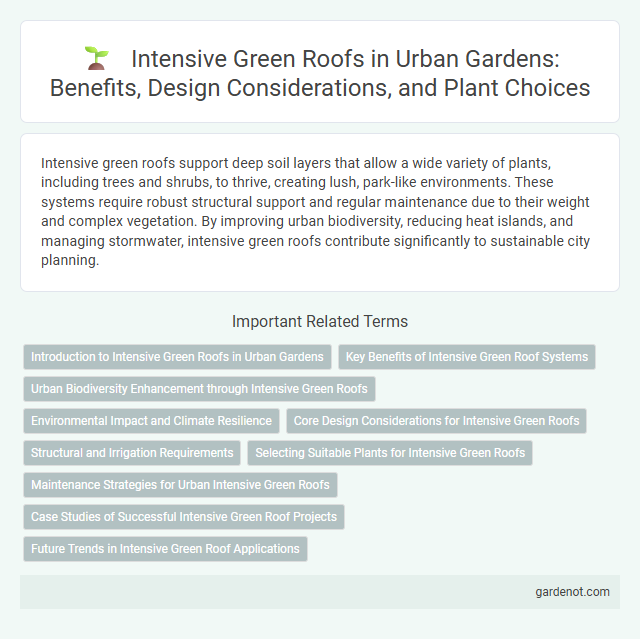Intensive green roofs support deep soil layers that allow a wide variety of plants, including trees and shrubs, to thrive, creating lush, park-like environments. These systems require robust structural support and regular maintenance due to their weight and complex vegetation. By improving urban biodiversity, reducing heat islands, and managing stormwater, intensive green roofs contribute significantly to sustainable city planning.
Introduction to Intensive Green Roofs in Urban Gardens
Intensive green roofs feature deep soil layers exceeding 200mm, supporting a diverse range of plants including shrubs, trees, and grasses, enhancing urban biodiversity and aesthetic appeal. These systems require robust structural support and regular maintenance such as irrigation and fertilization to sustain plant health in urban garden environments. Intensive green roofs contribute to improved stormwater management, thermal insulation, and urban heat island mitigation, making them valuable components in sustainable urban landscape design.
Key Benefits of Intensive Green Roof Systems
Intensive green roof systems offer substantial environmental benefits including enhanced stormwater management by retaining large volumes of rainwater and reducing urban heat island effects through their thick vegetation layers. These roofs support biodiversity by accommodating a wide variety of plant species, creating urban habitats for pollinators and birds. Their structural design also provides excellent thermal insulation, leading to significant energy savings and increased building lifespan.
Urban Biodiversity Enhancement through Intensive Green Roofs
Intensive green roofs create diverse habitats by supporting a variety of plant species, which attract pollinators, birds, and beneficial insects in urban environments. These roofs contribute to urban biodiversity by providing essential resources and corridors for wildlife, mitigating habitat loss caused by urbanization. Enhanced vegetation complexity on intensive green roofs improves ecological resilience and fosters sustainable urban ecosystems.
Environmental Impact and Climate Resilience
Intensive green roofs significantly enhance urban biodiversity by supporting a wide variety of plant species and providing habitats for birds and insects, which strengthens local ecosystems. These roofs improve stormwater management through increased water retention, reducing runoff and mitigating flood risks in densely built environments. Their ability to moderate building temperatures contributes to energy savings and helps cities become more resilient to climate change by lowering urban heat island effects.
Core Design Considerations for Intensive Green Roofs
Intensive green roofs require a robust structural design capable of supporting heavy loads due to deep soil layers, typically ranging from 6 to 24 inches, which sustain diverse plant species including trees and shrubs. Proper irrigation and drainage systems are critical to maintain plant health and prevent water accumulation that can damage roofing materials. Load-bearing capacity, waterproofing membranes, root barriers, and access for maintenance are essential design considerations to ensure durability and functionality of intensive green roofs.
Structural and Irrigation Requirements
Intensive green roofs require robust structural support due to their heavier soil depth, typically ranging from 6 to 24 inches, accommodating a diverse range of plants including shrubs and small trees. Their substantial weight necessitates reinforced roofing systems designed to bear loads of 80 to 150 pounds per square foot or more. Irrigation systems are essential to maintain plant health, often involving automated drip or sprinkler setups to manage water efficiently and address the extensive moisture needs of deep substrates and varied vegetation.
Selecting Suitable Plants for Intensive Green Roofs
Selecting suitable plants for intensive green roofs involves focusing on species with deep root systems and high tolerance to variations in moisture and sunlight. Broadleaf perennials, shrubs, and small trees are ideal due to their ability to thrive in thicker soil substrates, promoting biodiversity and enhancing insulation. Native or regionally adapted plants reduce maintenance needs and improve the overall sustainability of intensive green roof systems.
Maintenance Strategies for Urban Intensive Green Roofs
Intensive green roofs require regular maintenance strategies including irrigation, pruning, and soil fertility management to support diverse plant species and ensure structural integrity. Urban intensive green roofs benefit from scheduled inspections to monitor drainage systems and prevent waterlogging, which is essential for plant health and building safety. Incorporating adaptive maintenance plans tailored to seasonal variations improves the longevity and ecological performance of intensive green roof systems in metropolitan environments.
Case Studies of Successful Intensive Green Roof Projects
Intensive green roofs, characterized by deeper soil layers averaging 6 to 24 inches, support a wide variety of plants including trees and shrubs, demonstrated by successful projects such as the Chicago City Hall rooftop garden and the California Academy of Sciences living roof. These case studies highlight significant benefits like improved stormwater management, enhanced urban biodiversity, and energy savings, supported by robust irrigation and structural systems. Data from these projects emphasize increased vegetation diversity, with Chicago's City Hall roof achieving over 150 plant species that contribute to urban heat island reduction and sustainable building practices.
Future Trends in Intensive Green Roof Applications
Future trends in intensive green roof applications emphasize the integration of smart irrigation systems and renewable energy technologies to enhance sustainability and resource efficiency. Advances in plant selection prioritize native and drought-resistant species to improve biodiversity and reduce maintenance costs. Increasing urbanization drives demand for multifunctional green roofs that provide recreational spaces, urban agriculture, and stormwater management.
Intensive green roof Infographic

 gardenot.com
gardenot.com